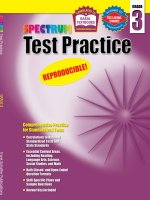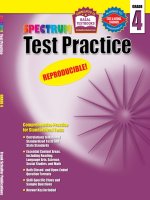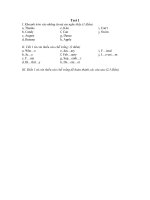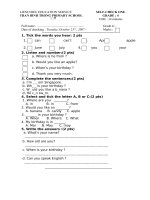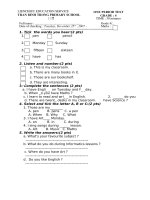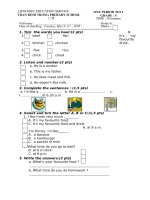Fresh reads for differentiated test practice grade 4 TM 187p
Bạn đang xem bản rút gọn của tài liệu. Xem và tải ngay bản đầy đủ của tài liệu tại đây (3.24 MB, 187 trang )
NOTES TO THE TEACHER
Introduction
Fresh Reads for Differentiated Test Practice is designed to provide
differentiated practice in reading comprehension skills and to prepare students
to take the Reading/Language Arts section of standardized tests, state tests,
or teacher-made tests. The student book includes the weekly differentiated
practice tests to strengthen comprehension skills taught in Scott Foresman
Reading Street. This Teacher’s Manual includes the following: (1) notes on
how to use the Fresh Read tests, (2) instructions on how to administer and
score a fluency test, (3) a chart on which you may record the progress of your
students, and (4) annotated copies of all of the Fresh Read tests indicating the
correct answer to all questions.
How to Use the Fresh Read Tests
The purpose of the Fresh Read tests is to give weekly differentiated practice in
target comprehension skills taught in Scott Foresman Reading Street.
This book contains three Fresh Read tests for each week to be used
independently from the main selection in Scott Foresman Reading Street. The
tests consist of a “Fresh Read” leveled passage and related comprehension
items that focus on the target and review comprehension skills of the week but
are written to address varying levels of proficiency—Strategic Intervention
(SI), On-Level (OL), and Advanced (A). A code at the bottom of each page
tells you the level of each test.
© Pearson Education 4
You can assess students’ proficiency levels using their responses to discussion
questions in class and their work on the comprehension pages in the
Practice Book or Teacher’s Resource Book. Fresh Read tests can be done
independently, or you may choose to work through them with students in small
groups, in order to give support and assess students’ progress.
Fresh Reads
v
Other ways to use the Fresh Read test pages:
• use the Strategic Intervention pages for whole-class practice with the
comprehension skills and/or test-taking skills
• use the Strategic Intervention pages after introducing the target and review
comprehension skills but prior to reading the main selection in the student
anthology of Scott Foresman Reading Street to assess students’ readiness
to read that selection
• use the On-Level pages as an assessment tool to check students’
understanding of the comprehension skills and/or test-taking skills
• use the On-Level pages to check students’ need for further practice,
reteaching, or more challenging materials
• use the Advanced pages as a substitute for the comprehension pages in
the Practice Book or Teacher’s Resource Book for students working above
grade level
© Pearson Education 4
• use any of the pages as preparation for the unit Benchmark Test
vi
Fresh Reads
How to Administer and Score a Fluency Test
A fluency test measures a student’s reading rate, or the number of words
correctly read per minute (wcpm), on grade-level text the student has not seen
before. You may want to use a copy of one of the “On-Level” leveled passages
from the Fresh Read tests for this purpose. Make a photocopy for yourself of
the passage you will give the student. (The pages in this Teacher’s Manual
have a scale of running numbers to make it easier for you to know how many
words the student read during the fluency check, while the passages in the
student edition do not have the numbers.) Make sure you have put the student’s
name and the test date at the top of your copy of the passage. Have a watch or
clock with a second hand available for timing the reading.
Give the student a copy of the passage for the test. Note: The student should
NOT have seen the passage beforehand; it is a “fresh” reading passage for
the student. Do NOT allow the student to read the passage silently before oral
reading.
Have the student read the text aloud. Do not have the student read the title as
part of the fluency reading; it is not included in the running word count. (You
may want to tape-record the student’s reading for later evaluation.) Stop the
student at exactly one minute and note precisely where the student stopped.
As the student reads orally, on your copy of the text mark any miscues or
errors the student makes during the reading (see the chart on page viii). Count
the total number of words the student read in one minute. Subtract any words
the student read incorrectly. Record the words correct per minute score on the
test.
The formula is: Total # of words read – # of errors = words correct per minute
(wcpm).
© Pearson Education 4
You will likely want to keep the test in your folder for the student. You may
also want to record students’ progress on the Reading Fluency Progress Chart
on page xi.
Fresh Reads
vii
How to Identify Reading Miscues/Errors
Using the passage on page ix, the chart below shows the kinds of miscues
and errors to look for as a student reads aloud and the notations to use to
mark them.
Reading Miscue
Notations
Omission
The student omits words or word
parts.
You can whip up a batter in a matter
of minutes.
Substitution
The student substitutes words or
parts of words for the words in the
text.
First, mix a tablespoon of baking
and
powder with a half cup of flour.
Insertion
The student inserts words or parts of
words that are not in the text.
The name depends on where you
too
live..
Mispronunciation/Misreading
The student pronounces or reads a
word incorrectly.
This all-American food is delicious
and easy to make.
Hesitation
The student hesitates over a word
and the teacher provides the word.
But they go by other names as well,
H
including griddle cakes and hot
cakes.
Self-correction
The student reads a word incorrectly
but then corrects the error.
Slowly mix the dry ingredients with
the wet ones.
delicate
sc
Notes
• If the student hesitates over a word, wait several seconds before telling the
student what the word is.
• Self-correction is not counted as an actual error. However, writing “SC”
over the word or words will help you identify words that give the student
some difficulty.
viii
Fresh Reads
© Pearson Education 4
• If a student makes the same error more than once, count it as only one
error.
Sample Fluency Test
Here is the passage marked as shown on the previous page. This is the “OnLevel” passage from Grade 4, Unit 1, Week 1. As the student reads the passage
aloud to you, mark miscues and errors. Have the student read for exactly one
minute, and then mark the last word the student reads.
Name
9/4/2009 107
Susan
Because of Winn-Dixie
Flapjacks
You may know them as flapjacks. But they go by other names as well, including
H
too
griddle cakes and hot cakes. The name depends on where you live. Still, most
Americans know a pancake when they see one.
delicate
This all-American food is delicious and easy to make. You can whip up a batter
15
29
37
52
in a matter of minutes. All you need is milk, an egg, butter, flour, baking powder,
68
and oil.
70
and
First, mix a tablespoon of baking powder with a half cup of flour. Next beat
85
together the egg with a half cup of milk and a quarter cup of oil. Slowly mix the dry
104
ingredients with the wet ones.
109
sc
Now your batter is ready. Heat up a large frying pan and add two tablespoons
124
of butter. Pour spoonfuls of batter into the melted butter. Let the pancakes fry until
139
they are golden brown on the bottom. Flip them over and brown them on the other
155
side. Serve the pancakes hot with maple syrup, honey, or jam.
166
© Pearson Education 4
112 - 5 = 107
Total number of words read 112
number of errors
– 5
Words correct per minute
Fresh Reads
107
ix
Interpreting the Results
According to published norms for oral reading fluency, students at the end of
Grade 4 should be reading fluently at 130 words correct per minute in text that
is on grade level. This chart gives recommended progress toward that goal.
End of Unit/Grade
Reading Rate (wcpm)
Grade 4
Unit 1
95 to 105
Grade 4
Unit 2
100 to 110
Grade 4
Unit 3
105 to 115
Grade 4
Unit 4
110 to 120
Grade 4
Unit 5
115 to 125
Grade 4
Unit 6
120 to 130
End of Year Goal
130
© Pearson Education 4
If a student’s reading rate is lower than the suggested progress toward the
standard for his or her grade level, your notes on the student’s miscues may
help you determine why the rate is low. Does the student make errors that
indicate his or her decoding skills are poor? If so, further instruction in phonics
may be needed. Do the errors reflect a lack of comprehension or limited
vocabulary? In that case, instruction in comprehension strategies and exposure
to more vocabulary words may help. A lack of fluency may indicate a lack of
exposure to models of fluent oral reading. It may also mean that the student
isn’t reading enough material at his or her reading level. “Matching Students to
Texts” in the Additional Resources section at the back of the Scott Foresman
Reading Street Teacher’s Editions gives suggestions on increasing reading
fluency.
x
Fresh Reads
Reading Fluency Progress Chart
Unit 1
Student’s Name
Date
WCPM
Unit 2
Date
WCPM
Unit 3
Date
WCPM
Unit 4
Date
WCPM
Unit 5
Date
WCPM
Unit 6
Date
WCPM
1.
2.
3.
4.
5.
6.
7.
8.
9.
10.
11.
12.
13.
14.
15.
16.
17.
18.
19.
20.
21.
22.
23.
24.
25.
© Pearson Education 4
26.
27.
28.
29.
30.
31.
32.
33.
34.
35.
Fresh Reads
xi
Because of Winn-Dixie
Name
Read the selection. Then answer the questions that follow.
Beach Party
Deb shook the crumbs off her beach towel and started off across the sandy beach
15
to the lake. A strong wind was blowing, and the sun had disappeared behind black
30
clouds. Very exciting weather, Deb thought.
36
“Where do you think you’re going?” asked her mother, who was busy filling a
beach bag. “That storm is coming in fast.”
50
58
“Oh, Mom,” said Deb. “Let’s just stay till it starts to rain.”
70
“No way,” said her mother. “This is a dangerous place to be in a storm. Don’t
86
you know that lightning is attracted to water?”
Reluctantly Deb turned back. Quickly they finished packing and then carried
94
105
everything to the car. Suddenly a flash of lightning lit up the sky, followed
119
immediately by a crash of thunder. Rain began to fall in big fat drops that came
135
faster and faster.
138
143
© Pearson Education 4
“Just in time,” said Deb.
Turn the page.
Fresh Reads
Unit 1 Week 1 SI
1
Answer the questions below.
1
What did Deb do right before her mother said, “Where do you think you’re going?”
A carried their things to the car
B said, “Just in time”
C walked toward the lake
D shook the crumbs out of her beach towel
2
Which of these events happened last in this story?
F The clouds covered the sun.
G It began to rain.
H There was a crash of thunder.
J There was a flash of lightning.
3
Why did the author end the story with the words “Just in time”?
A to make it clear that Deb obeyed her mother
B to remind the reader that time is important
C to show that Deb was safely in the car
D to point out the moral of the story
4
How did Deb’s mother know that a storm was coming? Use sequence words in your answer.
© Pearson Education 4
First the wind began to blow, and then black clouds covered
the sun.
2
Fresh Reads
Unit 1 Week 1 SI
Because of Winn-Dixie
Name
Read the selection. Then answer the questions that follow.
Flapjacks
You may know them as flapjacks. But they go by other names as well, including
15
griddle cakes and hot cakes. The name depends on where you live. Still, most
29
Americans know a pancake when they see one.
37
This all-American food is delicious and easy to make. You can whip up a batter
52
in a matter of minutes. All you need is milk, an egg, butter, flour, baking powder,
68
and oil.
70
First, mix a tablespoon of baking powder with a half cup of flour. Next beat
85
together the egg with a half cup of milk and a quarter cup of oil. Slowly mix the dry
104
ingredients with the wet ones.
109
Now your batter is ready. Heat up a large frying pan and add two tablespoons
124
of butter. Pour spoonfuls of batter into the melted butter. Let the pancakes fry until
139
they are golden brown on the bottom. Flip them over and brown them on the other
155
side. Serve the pancakes hot with maple syrup, honey, or jam.
166
This simple recipe has many variations. Some people use buttermilk instead of
178
milk. Others use yogurt mixed with milk. Some cooks mix whole wheat, cornmeal,
191
or oats into the flour. Of course, choices for pancake toppings are endless. Fruit,
205
chocolate, and whipped cream are just a few favorites.
214
221
© Pearson Education 4
How do you like your hot cakes?
Turn the page.
Fresh Reads
Unit 1 Week 1 OL
3
1
What do you do after you mix the egg, milk, and oil?
A pour batter into the frying pan
B mix dry and wet ingredients
C add butter to the frying pan
D add buttermilk to the mix
2
For cornmeal pancakes, when should you add the cornmeal?
F after you heat the frying pan
G after you add the toppings
H when you mix the wet ingredients
J when you mix the dry ingredients
3
What happens right after you add butter to the frying pan?
A You add the flour.
B You serve the pancakes.
C The butter melts.
D Pancake toppings are endless.
4
The author probably wrote this selection to
F explain how to make pancakes.
G convince the reader that pancakes are great for breakfast.
H entertain the reader with an interesting story about pancakes.
J express strong feelings about pancakes.
5
List the three main things you have to do to make pancakes. Use sequence words in your
answer.
First, get the ingredients. Then, mix the ingredients, or make a
batter. Finally, cook the pancakes.
4
Fresh Reads
Unit 1 Week 1 OL
© Pearson Education 4
Answer the questions below.
Because of Winn-Dixie
Name
Read the selection. Then answer the questions that follow.
Missing Dog
Barry raced into the house, forgetting to close the back door. He was late for his
16
baseball game and didn’t think about his mother’s warning to keep that door closed
30
so that Happy couldn’t push it open and escape.
39
Barry changed into his uniform and grabbed his mitt. He was about to leave
53
the house when he realized that he hadn’t seen Happy. At the same instant, Barry
68
noticed that the door was not quite closed. He called for the dog, but Happy did
84
not appear. He checked the entire house, but the mutt had vanished. If anything
98
happened to that dog, Barry thought, he would not forgive himself, and nobody else
112
in the family would either.
117
Barry spent the next hour searching the neighborhood for Happy. He asked all his
131
neighbors the same question: “Have you seen a little black-and-white mutt with big
144
paws and enormous ears that is really friendly?”
152
They all shook their heads sympathetically.
158
Barry had just started designing a LOST DOG poster when his mother’s car
171
187
news, when he caught sight of Happy sitting in the backseat. His mother rolled
201
down the window and said, “Aren’t you supposed to be at the baseball game?”
215
© Pearson Education 4
pulled into the driveway. He jogged over to her and was about to announce the bad
Turn the page.
Fresh Reads
Unit 1 Week 1 A
5
Answer the questions below.
1
What happened before the events described in this story took place?
A Barry played in a ball game.
B Barry’s mother let the dog out the back door.
C Barry changed into his uniform and grabbed his mitt.
D Barry’s mother warned him to keep the back door closed.
2
What happened right after Barry came into the house?
F He noticed that Happy was missing.
G He changed into his uniform.
H His mother took the dog with her.
J He shouted for the dog.
3
Why did Barry look for Happy in the house first?
A Happy was supposed to be in the house.
B He knew that Happy had not left the house.
C He did not have time to search the neighborhood.
D Happy could open the back door.
4
What information did the author hold back in order to have a surprise ending?
5
At the end of the story, what did Barry probably do next?
Answers may vary. Possible responses: Barry probably hurried
to get to the ball game; Barry probably asked his mother to
drive him to his ball game.
6
Fresh Reads
Unit 1 Week 1 A
© Pearson Education 4
Barry’s mother took Happy with her in the car. Happy was not
in the house when Barry left the door partly open.
Lewis and Clark and Me
Name
Read the selection. Then answer the questions that follow.
Rabbit Fools Coyote
Coyote was hiding behind a bush waiting for Rabbit to leave his hole. But Rabbit
15
was no fool. He knew just where Coyote was hiding and what he would be planning
31
to do.
33
One day when Rabbit left his hole, he carried a big bag and pretended that he had
to run slowly because the bag was so heavy. Soon Coyote overtook him.
“Before you eat me, please let me empty my bag,” Rabbit said. “My children are
all sleeping inside.”
50
63
78
81
94
looking forward to the delicious meal in the bag. He stuck his head and front paws
110
inside and yelled out “YEOW!” The bag was full of thorny cactuses.
122
© Pearson Education 4
Coyote laughed and grabbed the bag while Rabbit raced away. Coyote sat down,
Turn the page.
Fresh Reads
Unit 1 Week 2 SI
7
Answer the questions below.
1
Why do you think the author wrote this story?
A to convince the reader of an opinion
B to entertain the reader with a surprise ending
C to explain how to act in an emergency
D to express a feeling and create a mood
2
What did the author probably want you to think about Coyote?
F He was very clever.
G He got what he deserved.
H He should not have chased Rabbit.
J He was too proud of himself.
3
Why did Rabbit say his children were sleeping in the bag?
A He wanted Coyote to leave them alone.
B He wanted to show them to Coyote.
C He wanted Coyote to be quiet.
D He wanted to trick Coyote.
4
Do you think the author was trying to make you laugh? Explain by giving an example from the
story.
© Pearson Education 4
Answers may vary. Possible response: Yes, because Coyote
screams when he puts his head and paws in the bag before I
knew what was in it.
8
Fresh Reads
Unit 1 Week 2 SI
Lewis and Clark and Me
Name
Read the selection. Then answer the questions that follow.
Letter from a New Home
September 5
2
Dear Nadja,
4
I’ve put away my things in my new room, and my posters are on the walls. Now
21
this is starting to feel like home.
28
I can see the mountains and lots of pine trees from my window. My mom says I
45
can take skiing lessons this winter, so I can’t wait for the snow. There are a zillion
62
places to go ice skating and tobogganing. Who knows, maybe I’ll even learn to
76
snowboard!
77
Yesterday we hiked up a mountain path that led to a beautiful lookout. The land
92
stretched out for miles and miles across a canyon. Hawks were drifting in the sky,
107
and it was almost like a dream. My dad had brought a picnic, and we ate lunch
124
there. It was warm in the sun. By the time we got back to the car, I was tired and
144
cold and my muscles ached, but I slept well last night.
155
© Pearson Education 4
School starts on Monday, and I’m a little nervous about being the “new kid” here.
170
I just hope my teachers are nice and that I make some friends fast. If I could just
188
change one thing here, can you guess what it would be? You got it—you would still
205
live next door.
208
Your friend,
210
Rosa
211
P.S. Write back soon! You know how I love to get mail.
223
Turn the page.
Fresh Reads
Unit 1 Week 2 OL
9
1
Why do you think the author wrote this selection?
A to persuade the reader to move to the mountains
B to entertain the reader with interesting facts
C to describe what it’s like to be in a new home
D to explain why hiking is a great sport
2
In the paragraph that begins “School starts on Monday,” the author’s purpose is mainly to
F give information.
G ask a question.
H describe a place.
J express feelings.
3
The author’s purpose in the first part of the letter is to show that Rosa
A misses her friend.
B is getting used to a new home.
C is sorry that she moved away.
D likes to ski.
4
What caused Rosa to sleep so well the night before she wrote?
F unpacking
G hiking
H skiing
J feeling happy
5
Why do you think the author chose to write about moving to a new home?
Answers may vary. Possible responses: The author wrote
about moving to a new home because lots of people can
relate to it. Many people move, and everyone has different
feelings about moving.
10
Fresh Reads
Unit 1 Week 2 OL
© Pearson Education 4
Answer the questions below.
Lewis and Clark and Me
Name
Read the selection. Then answer the questions that follow.
Tornadoes Strike Three States
Friday, August 15
Last night, a string of tornadoes cut a thousand-mile path across Kansas,
3
16
Oklahoma, and Texas. The National Weather Service reported that in some areas,
28
winds reached 180 miles an hour.
34
Today, businesses are shut down across the three states. Trees and telephone
46
poles are uprooted. Power lines are down. Many areas are expected to be without
60
electricity or gas for several days.
66
Early yesterday evening, the weather service put out storm warnings. A strong
78
cold front was approaching a strong warm front, causing at least ten separate
91
tornadoes as well as huge downpours.
97
Many area residents are shaking their heads today. “I looked out the picture
110
window at sunset and saw two twisters coming my way,” recalled Mabel Brown. “I
124
just grabbed my cats and raced for the cellar.”
133
As it turned out, the storm bypassed Mrs. Brown’s home, but she had heard trees
148
cracking and glass crashing. She sat under a table with her pets for what seemed
163
like hours, she said. Actually it was just a few minutes.
174
188
mess. Still, I’m grateful that everyone is safe, and their houses are all standing. On
203
the whole, we were very, very lucky.”
210
© Pearson Education 4
A day after the tornado had passed, Mrs. Brown said, “The neighborhood is a
Turn the page.
Fresh Reads
Unit 1 Week 2 A
11
Answer the questions below.
1
What is the author’s main purpose in this selection?
A to entertain the reader
B to inform the reader with the latest news
C to warn the reader about tornadoes
D to tell the reader how to survive a tornado
2
Which of the following does the author use most to make the selection informative?
F short paragraphs and varied information
G technical terms and scientific information
H weather facts and historical information
J complex paragraphs and geographic information
3
What was the author’s main purpose in writing the paragraph that begins “Early yesterday
evening”?
A to catch the reader’s attention
B to explain the cause of the tornadoes
C to describe the area after the tornado
D to list problems the tornadoes caused
4
Why did Mrs. Brown feel as if she had been in the basement for hours instead of minutes?
5
Give one reason why you think the author quoted Mabel Brown.
Answers may vary. Possible responses: Mabel Brown may
have been quoted to show what the tornado was like for a
person who lived through one; to give a feeling of what it
was like to be close to a tornado.
12
Fresh Reads
Unit 1 Week 2 A
© Pearson Education 4
Answers may vary. Possible response: Mrs. Brown was
aware of the power of the storm, and since she was in an
uncomfortable situation, it seemed as though a lot of time
had gone by.
Grandfather’s Journey
Name
Read the selection. Then answer the questions that follow.
Wish Comes True
Dear Diary,
2
When I went to bed last night, I made a wish. When I woke up this morning, I
saw that my wish had come true. A blanket of snow covered the ground.
Mom fixed me pancakes before I put on my warmest coat, gloves, and boots. I
met Lisa at Cobb Hill with my sled.
Sledding down Cobb Hill is more fun than any ride at the amusement park. I love
20
34
49
57
73
coasting down with the wind in my face and the sun on my back. It’s a long trek
91
back up, but it’s worth it!
97
After we’d been sledding awhile, we met up with Nan and Betty. They had a
119
© Pearson Education 4
toboggan, and we all went down together.
112
Turn the page.
Fresh Reads
Unit 1 Week 3 SI
13
Answer the questions below.
1
Which of these events happened last?
A meeting Lisa
B meeting Nan and Betty
C going to Cobb Hill
D sledding down Cobb Hill
2
Which of these events happened before the writer woke up?
F Her mom gave her pancakes.
G Her wish came true.
H She met her friends.
J She put on her warmest coat.
3
What is the main idea of the third paragraph?
A Amusement parks are not very much fun.
B The day at Cobb Hill was windy and sunny.
C Sledding down Cobb Hill was a lot of fun.
D Cobb Hill was a long slope and hard to climb.
4
How would you get dressed to go sledding? Use sequence words in your answer.
© Pearson Education 4
Answers may vary. Possible response: First, I would put on my
snow pants and jacket. Then, I would put on my boots. Finally,
I would put on my hat and gloves.
14
Fresh Reads
Unit 1 Week 3 SI
Grandfather’s Journey
Name
Read the selection. Then answer the questions that follow.
Topeka Tess
No doubt you have heard tales of Pecos Bill and Paul Bunyan. The feats of
15
Topeka Tess are not so famous, not yet. Even so, there are people who brag about
31
her out on the Great Plains of these great United States.
42
Tess was born in farm country. In fact, her birthday fell right in the middle of the
biggest harvest of all times.
Tess came into this world like all babies, crying. However, her crying was
59
64
77
different. It was more like talking. “Please, oh please, Mama,” she bawled. “Let me
91
help Papa in the fields!” When her ma said she couldn’t because she was too little,
107
Topeka Tess let out a shout that could be heard from Kansas to Ohio.
121
When Tess turned two, she was harvesting her family’s fields all by herself. At
ten, she mowed every field in Kansas.
By the age of fifteen, Tess was ready for her biggest challenge ever. One
135
142
156
afternoon, Tess’s father got a call from a neighbor. Trouble was brewing. A giant
170
swarm of locusts was heading their way, gobbling up crops as they flew.
183
Tess set to work weaving a net. Then she waited for the swarm. When it arrived,
199
215
those bugs to help her mow the fields. Is it any wonder Topeka Tess is the hero of
233
America’s heartland?
235
© Pearson Education 4
she trapped every last locust in her net. Better yet, she used the wing power of
Turn the page.
Fresh Reads
Unit 1 Week 3 OL
15
1
When Tess was born, what was the first thing she did?
A let out a shout that could be heard for miles
B harvested her family’s fields all by herself
C cried until her mother picked her up
D begged to help her father in the fields
2
What did Tess have to do before she could catch the locusts?
F weave a net to trap them
G harvest her family’s fields
H mow every field in Kansas
J use the locusts to mow the fields
3
What would a field of corn look like after the locusts passed by?
A The corn would be stacked into piles.
B The field would be covered with a net.
C The corn would be waving in the wind.
D No corn would be left in the field.
4
What is the main idea of the last paragraph?
F Tess saved the crops by trapping the locusts.
G Tess was amazing at weaving nets.
H Tess could mow a field using locusts.
J Tess was faster than anyone on Earth.
5
What three important events took place in the selection and when did they occur? Use
sequence words in your answer.
First, Topeka Tess mowed the family’s fields. Then she mowed
every field in Kansas. Lastly, she saved all the fields from the
locusts.
16
Fresh Reads
Unit 1 Week 3 OL
© Pearson Education 4
Answer the questions below.
Grandfather’s Journey
Name
Read the selection. Then answer the questions that follow.
Subway Ride
Jen followed Nicky and her mother down a flight of stairs. Nicky’s mother
13
handed Jen a token. Jen slipped the coin into a slot and pushed through the turnstile.
29
Then they all went down another flight of stairs and onto the subway platform.
43
Jen heard a rumbling that sounded like an earthquake. She was bracing for the
57
walls to start shaking, when a train roared into the station. It screeched to a stop
73
in front of them. There was a crowd waiting to get on the train. Jen, Nicky, and
90
Nicky’s mother got on with them.
96
The seats filled up before Jen or Nicky could sit down. “Hang on to that bar,”
112
said Nicky’s mother, and Jen held on for dear life. The train began to speed up and
129
then entered a dark tunnel. Nicky said something to Jen, but she could not hear a
145
word over the rumbling of the train.
152
After a minute, the train came to another screeching halt. “Six more stops to the
aquarium,” Nicky said.
By the time the train reached the aquarium stop, Jen was used to the noise and
167
170
186
203
train very exciting. She just hoped their trip to the aquarium would be as much fun.
219
© Pearson Education 4
the motion of the train. In fact, she had found her first ride on a Boston subway
Turn the page.
Fresh Reads
Unit 1 Week 3 A
17
Answer the questions below.
1
What did Jen do right after she slipped the token into the slot?
A braced for the tunnel walls to shake
B went down a flight of stairs
C held on for dear life
D pushed through the turnstile
2
What is the first paragraph mostly about?
F riding on a subway train for the first time
G going from the street to the subway platform
H taking the subway to the aquarium in Boston
J taking a sightseeing trip in a strange city
3
What will Jen and Nicky probably do next?
A have lunch with Nicky’s mother
B go to the aquarium with Nicky’s mother
C go shopping with Nicky’s mother
D ride the subway to the hotel
4
Tell what happened after the train started and before it reached the next stop. Use sequence
words in your answer.
5
What will Jen and Nicky probably have to do to get out of the subway?
They will have to climb some steps and go out through a
turnstile.
18
Fresh Reads
Unit 1 Week 3 A
© Pearson Education 4
First the train sped up, and then it entered a tunnel.

